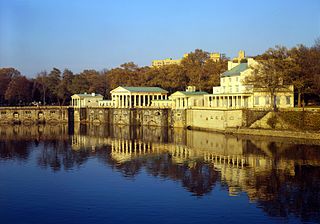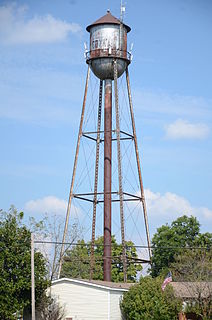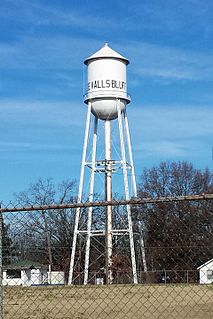
Woodruff County is located in the Arkansas Delta in the U.S. state of Arkansas. The county is named for William E. Woodruff, founder of the state's first newspaper, the Arkansas Gazette. Created as Arkansas's 54th county in 1862, Woodruff County is home to one incorporated town and four incorporated cities, including Augusta, the county seat. The county is also the site of numerous unincorporated communities and ghost towns. Occupying only 587 square miles (152,000 ha), Woodruff County is the 13th smallest county in Arkansas. As of the 2010 Census, the county's population is 7,260 people in 3,531 households. Based on population, the county is the second-smallest county of the 75 in Arkansas. Located in the Arkansas Delta, the county is largely flat with fertile soils. Historically covered in forest, bayous and swamps, the area was cleared for agriculture by early settlers. It is drained by the Cache River and the White River. Along the Cache River, the Cache River National Wildlife Refuge (NWR) runs north–south across the county, preserving bottomland forest, sloughs and wildlife habitat.

The Fairmount Water Works in Philadelphia, Pennsylvania, was Philadelphia's second municipal waterworks. Designed in 1812 by Frederick Graff and built between 1812 and 1872, it operated until 1909, winning praise for its design and becoming a popular tourist attraction. It now houses a restaurant and an interpretive center that explains the waterworks' purpose and local watershed history. It was designated a National Historic Landmark in 1976 for its architecture and its engineering innovations. It was the nation's first water supply to use paddle wheels to move water.

The Shreveport Waterworks Pumping Station, also known as the McNeil Street Pump Station, is a historic water pumping station at 142 North Common Street in Shreveport, Louisiana. Now hosting the Shreveport Water Works Museum, it exhibits in situ a century's worth of water pumping equipment, and was the nation's last steam-powered waterworks facility when it was shut down in 1980.

The Bethlehem Waterworks, also known as the Old Waterworks or 1762 Waterworks, is believed to be the oldest pump-powered public water supply in what is now the United States. The pumphouse, which includes original and replica equipment, is located in the Colonial Industrial Quarter of downtown Bethlehem, Pennsylvania, between the Monocacy Creek and Main Street. It was declared a National Historic Civil Engineering Landmark in 1971, an American Water Landmark in 1971, and a National Historic Landmark in 1981. The building is a contributing property to the Historic Moravian Bethlehem District which was designated as a National Historic Landmark District in 2012 and later named to the U.S. Tentative List in 2016 for nomination to the World Heritage List.

Lockesburg Waterworks are a water storage and distribution facility at the junction of Hickory and Azalea Streets in Lockesburg, Arkansas. The facility consists of a water tower and three water storage sheds, of which the tower was built in 1936 with funding assistance from the Public Works Administration, a Depression-era works project. The older shed was built in 1945, and the second was built in 1990. The tower is a metal structure with four legs supported and stabilized by cross bracing, with a metal tank at the top which is sheltered by a conical roof. The oldest shed is a modest square brick structure at the center of the complex, while the 1990 shed is located at the southwest corner of the property.

The Waldo water tower is a historic elevated steel water tower located in Waldo, Arkansas, United States, that is listed on the National Register of Historic Places.

The Chillicothe Water and Power Company Pumping Station is a historic building on the northern side of Chillicothe, Ohio, United States. A Gothic Revival structure built in 1881, it was constructed to house the city's waterworks and power plant. Its architecture and its location in Yoctangee Park was chosen specifically in order to beautify the park as well as to have a location near other elements of the city's first waterworks, which were built at the same time as the pumping station.

The Pittsburgh-Des Moines Steel Company, and often referred to as Pitt-Des Moines Steel or PDM was an American steel fabrication company. It operated from 1892 until approximately 2002 when its assets were sold to other companies, including Chicago Bridge & Iron Company. The company began as a builder of steel water tanks and bridges. It also later fabricated the "forked" columns for the World Trade Center in the 1960s, and was the steel fabricator and erector for the Gateway Arch in St. Louis. A number of its works are listed on the National Register of Historic Places.

The Hampton Waterworks is a historic site located in Hampton, Arkansas. Completed in 1937, it is the only surviving example of a Public Works Administration-built waterworks in Calhoun County. The site contains a good example of a 1930s-era elevated steel water tower, built by the Pittsburgh-Des Moines Steel Company. The site was added to the National Register of Historic Places in 2006.

The Cotter water tower is a historic elevated steel water tower located in Cotter, Arkansas. It was constructed in 1935 by the Pittsburgh-Des Moines Steel Company, as part of the development of the local water supply system by the Public Works Administration. The tower was added to the National Register of Historic Places in 2007, as part of a multiple-property listing that included numerous other PWA-era projects in Arkansas, under the heading “An Ambition to Be Preferred: New Deal Recovery Efforts and Architecture in Arkansas, 1933-1943.”

The Cotton Plant water tower is a historic elevated steel water tower located in Cotton Plant, Arkansas. It was built in 1935 by the Pittsburgh-Des Moines Steel Company in conjunction with the Public Works Administration as part of a project to improve the area's water supply. It was added to the National Register of Historic Places in 2008, as part of a multiple-property listing that included numerous other New Deal-era projects throughout Arkansas.

The Mineral Springs Waterworks is a historic site located in Mineral Springs, Arkansas. It contains a good example of a 1930s-era elevated steel water tower, built in 1936 by the Pittsburgh-Des Moines Steel Company in conjunction with the Public Works Administration as part of a project to improve the town's water supply. The tower was built to store water obtained from a nearby well. It was added to the National Register of Historic Places in 2007, as part of a multiple-property listing that included numerous other New Deal-era projects throughout Arkansas. A new water well was drilled nearby in 1985; however, the original water tower still stands. The Mineral Springs Waterworks remains in operation.

The Monette Water Tower is a historic structure located at the junction of Arkansas Highway 139 and Texie Avenue in Monette, Arkansas. It was built in 1936 by the Chicago Bridge & Iron Company in conjunction with the Public Works Administration as part of a project to improve the area's water supply. The Monette Water Tower is considered a good example of a 1930s-era elevated steel water tank. It was added to the National Register of Historic Places in 2008, as part of a multiple-property listing that included numerous other New Deal-era projects throughout Arkansas.

The Monette Water Tower is a historic elevated steel water tower located in Hartford, Arkansas. It was built in 1936 by the Chicago Bridge & Iron Company in conjunction with the Public Works Administration as part of a project to improve the local water supply. The project was one of 124 similar projects in the state funded by the PWA. It was added to the National Register of Historic Places in 2008, as part of a multiple-property listing that included numerous other New Deal-era projects throughout Arkansas.

The Tyronza Water Tower is a historic elevated steel water tower located in Tyronza, Arkansas. It was built in 1935 by the Chicago Bridge & Iron Company in conjunction with the Public Works Administration as part of a project to improve the local water supply. It was added to the National Register of Historic Places in 2007, as part of a multiple-property listing that included numerous other New Deal-era projects throughout Arkansas. The Tyronza Water Tower is considered an excellent representation of 1930s-era waterworks construction.

The De Valls Bluff Waterworks is a historic public water supply facility at Rumbaugh and Hazel Streets in De Valls Bluff, Arkansas. It contains a 1930s-era elevated steel water tower, built in 1936 by the Pittsburgh-Des Moines Steel Company in conjunction with the Public Works Administration as part of a project to improve the local water supply. It was added to the National Register of Historic Places in 2007, as part of a multiple-property listing that included numerous other New Deal-era projects throughout Arkansas. The property also contains several non-contributing buildings, including a shed, aeration chamber and water tank.

The Keiser Water Tower is a historic waterworks facility at Water and East Main Street in Keiser, Arkansas. It is an open metal structure, several stories high, with a roughly cylindrical tank at the top, and a rising through the center to provide water to the tank. A ladder providing access to the tank is fixed to one of the legs, and there is a circular catwalk with railing around the tank. The structure was built in 1936 with funding from the Public Works Administration, and is one of the few Depression-era structures left in the small community.

The Tuckerman Water Tower is a historic waterworks facility at the south end of Front Street in Tuckerman, Arkansas. It is a tall metal structure, with four latticed legs, braced with rods and sloping inward, to support a water tank that is bowl-shaped at the bottom and topped by a conical roof. A pipe traverses the center of the tower for the movement of water to and from the tank. Built in 1935 with funding support from the Depression-era Public Works Administration (PWA), it is the only remaining PWA tower of its type in the county.

The Mountain View Waterworks are a historic public water supply system in Mountain View, Arkansas. The facilities consist of a tower and well house, located at the junction of Gaylor and King Streets. The tower is a metal structure with four legs, reinforced by diagonal latticework members, topped by a water tank with a bowl-shaped bottom and a conical roof. A large pipe connects from the bottom of the tank to the well house, a square fieldstone structure. These facilities were built in 1936–37 with funding from the Public Works Administration, and were still in use at the time of the property's listing on the National Register of Historic Places in 2006.

Towering over the City of Bunnell is the city's most visible and iconic landmark: the City of Bunnell elevated steel water tower. The water tower is located at 100 Utility Street, Bunnell, FL 32110. It was built in 1926 by Chicago Bridge & Iron Company as part of a new waterworks system for Bunnell that went into operation in December 1927 and has been providing water to residents and local businesses to this day. The water tower is 110 feet high and its elevated steel tank holds 75,000 gallons of water. The elevated steel water tank has a conical top, Horton hemispherical bottom and is supported by four steel columns (legs) and reinforced with steel cross braces. The east and west sides of the elevated tank have black painted signage that read “City of Bunnell, Crossroads of Flagler County”






















